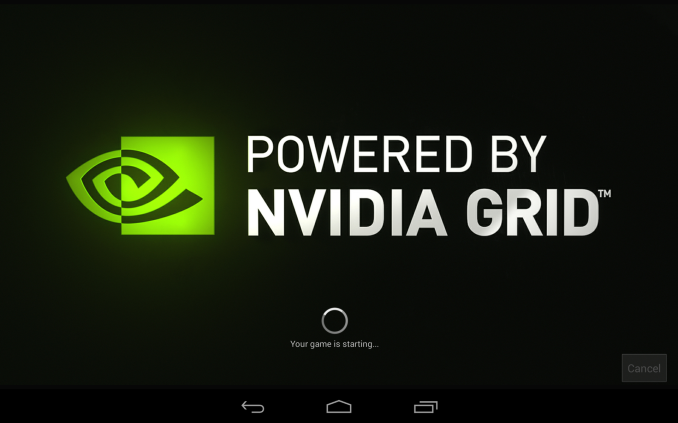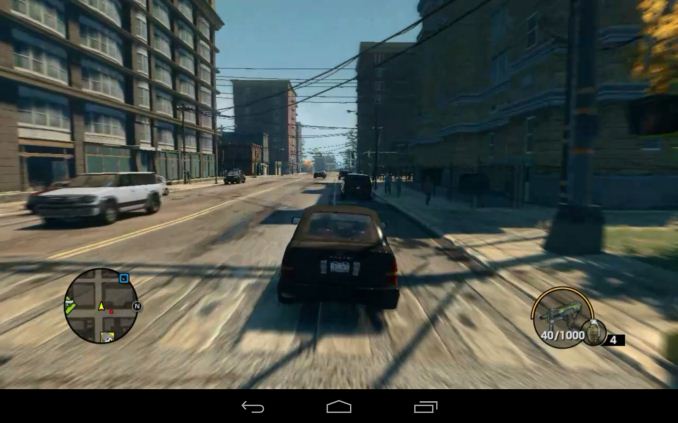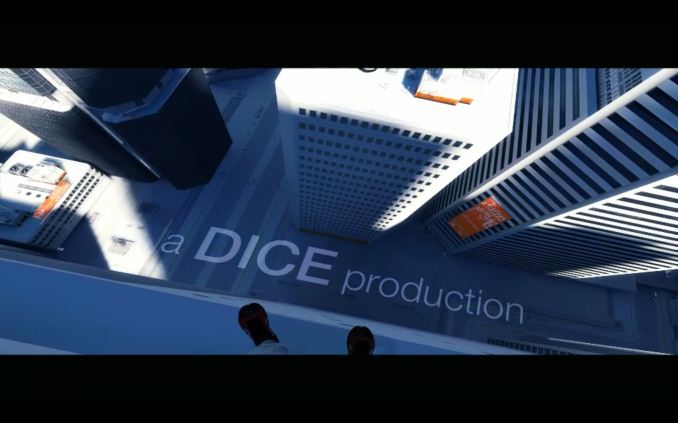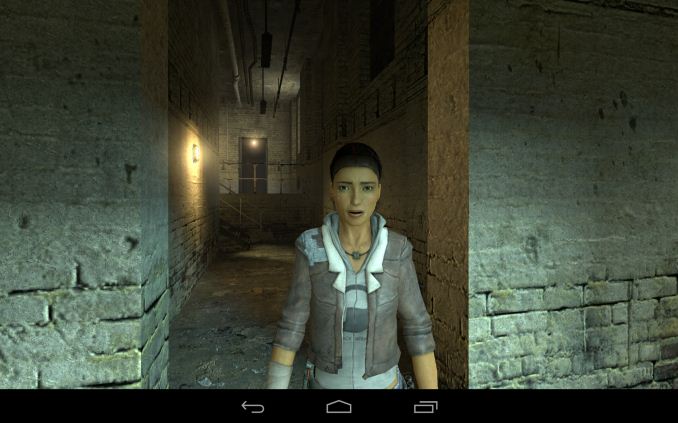The NVIDIA SHIELD Tablet Review
by Joshua Ho on July 29, 2014 9:00 AM ESTGameStream and GRID
The final software features that Shield Tablet brings to the table are GameStream and GRID. These are effectively methods of turning the tablet into a thin client, as all of the rendering/computation is done on a computer either in the LAN or on a server in San Jose. From a technical perspective, both work great as long as the connection has high bandwidth and low latency. For GRID, I managed to get a great user experience on a symmetrical 10 Mbps connection and around 10ms latency to the server. Games like Saints Row 3 played as if running on a console when the device is actually streaming from NVIDIA servers. From the user’s perspective, it’s a matter of going into the app drawer, opening GRID, and selecting a game. It’s simple and given sufficient server coverage I could easily see a Netflix-style usage model taking off quite successfully.
Although I didn’t spend as much time with GameStream, I didn’t detect any input lag and for the most part it’s just as simple. As long as a GameStream-enabled PC is on the same network, accessing GameStream compatible games is just a matter of going to the Shield Hub application, entering a four digit code on the PC to pair it with the tablet, and selecting a game. GameStream also works remotely, but the same caveats that come with GRID apply to GameStream on both the server and client end. Of course, the games that will run on GameStream have to be carefully selected. While it’s fully possible to play a twitch shooter like Call of Duty through GameStream, trying to use a controller in multiplayer is simply a massive disadvantage against people that are competent with a mouse and keyboard. I've included a screenshot of Mirror's Edge that I took while testing GameStream.
Gaming Ecosystem
Ultimately, I’m a bit conflicted on whether GameStream and GRID are really designed to stand on their own though. GameStream only works while you’re at home, and GRID is highly dependent upon low latency and also needs around 10 Mbps download and 5 Mbps upload for an ideal experience. Due to the latency requirement and the fact that the only GRID server bank is in San Jose, the very low latencies that GRID is best suited for are generally only achievable in California and parts of other nearby states. They’re definitely great in the situations that they work, but ultimately the native game library has to stand alone. To this end, the tablet is in a far better situation than the original Shield. The number of games that provide a quality gaming experience is now leaps and bounds better than what we saw with the launch of the Shield Portable. Trine 2 is included out of the box, and while I didn’t get a chance to try co-op mode it’s a compelling experience that once needed GameStream or GRID to be played on Shield. Along the same lines, the Grand Theft Auto series, Half Life 2, and Portal all play surprisingly well.
Fundamentally though, I don’t think single player games alone will sell Shield as a gaming platform. A single player game can only have a certain amount of replay value. Something like Half Life 2 might have 12 hours of gameplay at best. In comparison, multiplayer has massive amounts of replay value because even the same map can play out differently depending upon the people that play in the round. It’s that factor that makes it possible for people to spend 1200 hours playing a game like Battlefield 2. Unfortunately, for the most part the Shield tablet has a game library that seems to be skewed towards single player games. Fortunately, NVIDIA seems to understand this. While I haven’t been able to play War Thunder on Shield tablet, the promise of compelling multiplayer games on this device would be a strong enough reason to excuse potential shortcomings in other areas. Although it's good that an immersive multiplayer title is coming to Shield tablet, the key point of emphasis is that people playing a Shield device can play with those on console or PC as well. Until NVIDIA hits critical mass for Shield device adoption, multiplayer titles that only allow people on Shield to play with others on Shield will struggle because people won't play multiplayer unless there are other people to play with.















174 Comments
View All Comments
lmcd - Tuesday, July 29, 2014 - link
Well it's also the 2nd-most expensive tablet in the top 10, and most expensive in the top 5.Death666Angel - Tuesday, July 29, 2014 - link
How many people go to amazon to buy Apple products though? I would hazard a guess and say they more often than not get their gear through Apple stores directly?melgross - Tuesday, July 29, 2014 - link
Apple's tablet sales have been slightly on the down slide, wait for the new model, mode for a couple of months now. We'll what happens when the new ones come out in September.Jumangi - Tuesday, July 29, 2014 - link
The reality is the difference won't be "night and day" in the real world. The Nexus 7 is perfectly snappy using the 99.9% of apps that will actually be installed. Benchmarks are just that. So what if it gets 3 times the FPS on the T-Rex demo. There are real world practical reasons device makers have dumped Nvidia since the Tegra 3 for SoC vendors like Qualcomm. As powerful as the GPU is in this thing it will be a bit player in the worldwide SoC market.TheJian - Wednesday, July 30, 2014 - link
T4 is used in: Nvidia Shield, Tegra Note 7, Microsoft Surface 2, HP SlateBook x2, ZTE N988S, Nuvola NP-1, Project Mojo, Asus Transformer Pad Infinity (2013 model), Toshiba AT10-LE-A (Excite Pro), Vizio 10" tablet, Wexler.Terra 7, Wexler.Terra 10, Acer TA272HUL AIO, HP Slate 21 AIO, Xiaomi Phone 3, Wacom Cintiq Companion Hybrid, Coolpad, Mad Catz MOJO, BungBungame's Kalos tablet.More I can't be bothered to list, you should get the point. That's MS, HP, Toshiba, Acer, ASUS, Vizio, PNY/MSI/EVGA make the note7 IIRC, etc. How many vendors does a compnay need before you say a chip isn't failing?
K1 is coming in HTC Nexus 9, so google a bit player too? Nexus tablets sell very well. It was in everything google showed at Google IO this year (automotive, Tango, TV, Tablet). Seems to be a pretty decent bit player even before it really gets ramped. But whatever, I guess our definitions of bit player differ (greatly). You have to remember all revs before this were just buying time until desktop gpu met socs. Sort of like 7yrs it took to get cuda to dominate 90% of workstation graphics. With K1, many will know Nvidia's name is more than just PC gpus. Branding their own products was a brilliant move also, which will further this progress over time.
I hope they put out a 20nm console box (size of xbox1/ps4) with 125w psu and running 4ghz or something with HD or SSD etc, 16GB etc and put android gaming on the map for REAL. A 20nm Denver with Maxwell gpu should do fairly well and easily run 3.5-4ghz with a fan/heatsink on it in a big xbox1 like box (or TWO of them just like xbox1/ps4, Denver already runs 2.5ghz in a tablet). With 3.7B in the bank NV needs to start making $2-10mil games now in preparation for a CONSOLE launch that runs a triboot of linux, steamos (surely porting to ARM) and Android L with 64bit. Now that's a console I'd really like to see and streaming my PC also to that tv for PC games. To keep it cheap keep a slot empty for me to install a bluray on my own or have two options one with one without. No need for a 4K new bluray player then either. They need to start developing their own games and buy up some small software teams to get this done. With even just 200mil NV could pump out a good 50 $4mil games for android that really take advantage of their hardware and an announcement like that would cause some sales and gain major attention. Port them to PC later for more cash with amped up graphics. If you still fail to get your money back allow them to run on other devices as a last resort a year or two later after you've milked all the sales you can for your own devices. They only need to break even to push hardware sales, but I'm thinking they'd make some money on quite a few if they make quality games by small teams (like the grimrock guys, 4 guys made Legends of grimrock, snatch up teams like them).
NV is about to become a far larger player here just due to their desktop gpus migrating yearly to socs. You see the damage already in this review. The benchmarks will start to be well known as games start to be benchmarked for real and people wise up to who's running the best in GAMES. Qcom was great while modems dominated, we'll see how well they do in Nvidia's world now. NV will win the gpu war. Just ask Intel...LOL. Even AMD has a shot at making some cash if they'd get their butts in mobile gear (as in ARM, not x86 where Intel rules them). There is room in ARM land for both NV and AMD to rule many devices with gpus. Everyone already knows how to use their hardware inside out, Qcom has years to go here with ZERO experience in driver optimization for games etc. NV/AMD have been having a driver contest for 20yrs, and devs have been using their hardware for games for the same length of time. Good luck to everyone else here now that 50% of devs are making games for mobile devices (only PC tops that at 52%, consoles FAR behind these two).
titan10 - Thursday, July 31, 2014 - link
Just made an account to say that I loved your 'Just ask Intel...LOL',BTW great strategy... only if NV thinks same.savagemike - Tuesday, July 29, 2014 - link
We have an original N7 in the house and a 2013 N7. I want a little bigger screen and am really digging the idea of a stylus. Don't have a game console or a gaming desktop either. Not a huge gamer, obviously. But would probably use this for the occasional game. Just another bonus that it can do a decent job of that.Being a big percent heavier or thicker than something very light and very thin isn't a big deal in reality. What this Shield really seems to have is unending flexibility.
Knowname - Wednesday, July 30, 2014 - link
you can buy a stylus for 2 bucks lol though xD just sayin' this would obviously be a BETTER stylus and drawing apps, but if all you want is a stylus you might find your answer without emptying your wallet.SpartyOn - Tuesday, July 29, 2014 - link
A GTX 860m in a tablet? Surely this was a joke, right?The 860m pulls approximately 60w alone, maybe 50w if you paired it with DDR3 and downclocked it. In a tablet environment, you're looking at the entire SoC pulling 10w or less at load.
Not happening anytime soon.
That being said, if Nvidia could cram two Maxwell SMM units into the next Tegra vs. the one Kepler SMX in the K1, that would really be something.
schizoide - Tuesday, July 29, 2014 - link
I said crunch it down, obviously they wouldn't take the 60 watt card and plug it into a pci-e riser in a tablet. Compromises would be made, although less and less as time passes.My point was primarily that android gaming doesn't require high-end hardware, because the games target a low common denominator. An x86 windows based tablet makes a lot more sense for games.
Then again, most windows games require a mouse and keyboard.
Really, gaming tablets don't make sense as a separate market segment.